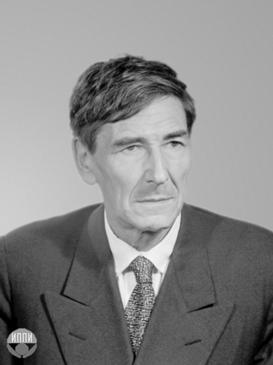Pyotr Novikov facts for kids
Quick facts for kids
Pyotr Novikov
|
|
|---|---|
| Пётр Но́виков | |

Novikov
|
|
| Born | 15 August 1901 |
| Died | 9 January 1975 (aged 73) Moscow, Soviet Union
|
| Alma mater | Moscow University |
| Known for | Novikov–Boone theorem |
| Spouse(s) | Lyudmila Keldysh |
| Children | Sergei Novikov |
| Scientific career | |
| Fields | Mathematics |
| Institutions | Steklov Institute of Mathematics Moscow State Teachers Training Institute Moscow D. Mendeleev Institute of Chemical Technology |
| Doctoral students | Sergei Adian Albert Muchnik |
Pyotr Sergeyevich Novikov (Russian: Пётр Серге́евич Но́виков) was a famous Soviet mathematician. He was born on August 15, 1901, in Moscow, Russia, and passed away on January 9, 1975, also in Moscow. Novikov was known for his important work in a field of math called group theory. His son, Sergei Novikov, also became a well-known mathematician.
Contents
Early Life and Education
Pyotr Sergeyevich Novikov was born in Moscow, which was then part of the Russian Empire. His father, Sergei Novikov, was a merchant, and his mother was Alexandra Novikov.
Pyotr served in the Red Army during the Russian Civil War. This was from 1920 until July 1922. After his military service, he continued his studies. He attended Moscow University from 1919 to 1920 and then again from 1922. He graduated from the university in 1925. He then did his graduate studies under the famous mathematician Nikolai Luzin, finishing in 1929.
Pyotr Novikov's Career in Mathematics
Novikov began his career at the Moscow D. Mendeleev Institute of Chemical Technology in 1929. He worked there until 1934. After that, he joined the Department of Real Function Theory at the Steklov Institute of Mathematics.
Becoming a Professor
In 1935, Novikov earned his doctorate degree. This is a very high academic achievement. He was then promoted to a full professor in 1939. In 1944, he became the head of the Department of Analysis at the Moscow State Teachers Training Institute.
Leading Mathematical Logic
Later, in 1957, Novikov became the first head of the Department of Mathematical Logic at the Steklov Institute. He held both of these important leadership roles at the same time for many years. He retired from these positions in 1972 and 1973.
His Students
Novikov also taught and guided many students. Two of his notable students were Sergei Adian and Albert Muchnik. They went on to become important mathematicians themselves.
Novikov's Key Research in Group Theory
Pyotr Novikov is most famous for his work on difficult problems in group theory. Group theory is a branch of mathematics that studies algebraic structures called groups.
The Word Problem
One of the big problems he worked on was the word problem for groups. Imagine you have a set of rules for combining things, like letters or numbers. The word problem asks if there's a way to tell if two different combinations of these things actually mean the same thing, using only the rules.
In 1955, Novikov proved something very important. He showed that for some groups, there is no computer program or step-by-step method (algorithm) that can always solve this "word problem." This discovery is known as the Novikov–Boone theorem. It means that for certain groups, you can't always figure out if two different ways of writing something represent the same element.
The Burnside Problem
He also made progress on another famous challenge in group theory called the Burnside problem. This problem asks about groups where every element, when combined with itself a certain number of times, always returns to the starting point.
Awards and Honors for His Work
Novikov received many awards and honors for his contributions to mathematics.
- In 1953, he was chosen as a corresponding member of the Academy of Sciences of the Soviet Union.
- He became a full member of the Academy in 1960.
- He was awarded the prestigious Lenin Prize in 1957. This was for his proof that the word problem in groups is "undecidable" for some cases.
- He received the Order of Lenin twice, in 1961 and again in 1971.
- He was also awarded the Order of the Red Banner of Labour.
- After his death, in 1999, he was given the State Prize of the Russian Federation.
Personal Life and Family
Pyotr Novikov was married to another mathematician, Lyudmila Keldysh (1904–1976). They both shared a love for mathematics.
Their son, Sergei Novikov (1938–2024), also became a very successful mathematician. He was the first Soviet mathematician to win the Fields Medal. This is one of the highest honors a mathematician can receive, often compared to the Nobel Prize.
Pyotr Novikov passed away in Moscow on January 9, 1975.
See also
 In Spanish: Piotr Nóvikov para niños
In Spanish: Piotr Nóvikov para niños

